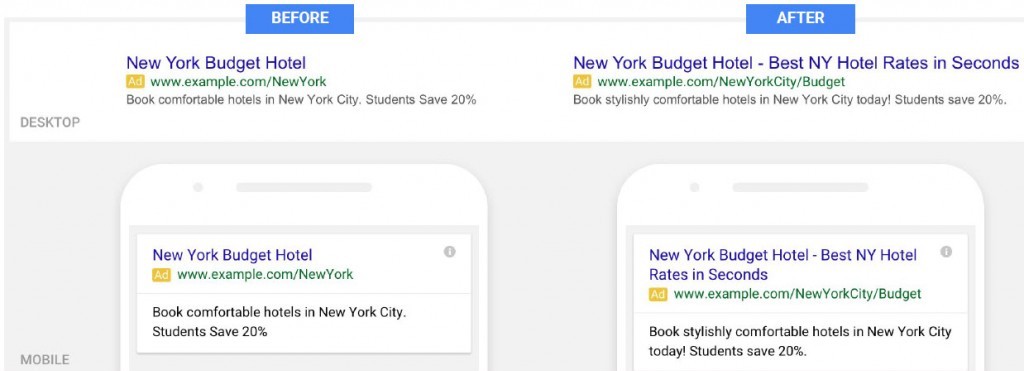New AdWords Format
Google is changing text ads which will give advertisers more copy to play with. The new changes come after the ads from the right side disappeared from the search engine result page, earlier this year, in order to create continuity between desktop and mobile. Without a side bar, Google has more space to streamline text ads between devices.
Up until now AdWords text ads have been formed of a 25-character headline, two 35-character description lines and a display URL. Google will now be testing out ads with two 30-character headlines, one 80-character description line and the display URL will automatically pull the landing page domain. However, advertisers will be able to offer two fictional directory paths, to provide description about the content of the landing page. See an example of the change below:
What this means is that advertisers get more copy. You get to keep the 70-character description lines, add another 10 plus an extended headline!
Since users seem to be drawn by the clickable headlines, and spend less time reading the description lines, Google has decided that two headlines instead of one will eventually increase click-through rates. Tests so far have reported increases of up to 20% in CTR. As usual, however, this is not such a great news for those on the organic side.
What Now?
1. This might not be what advertisers will want to hear but this change is an opportunity to write new ads. It will be tempting to just take the ads that are working well now, combine your current description lines and just add a new headline. This is the approach Google started with too. However, you will encounter a problem: you will be using more words to practically say the same thing which obviously makes them less effective. Many advertisers who just added a second headline have seen their CTR decrease. Instead advertisers should focus on using the extra character allowance to add more value and include the most important messaging in the headline like testing new call to actions and present unique selling propositions.
2. Dear advertisers – don’t run to pause your old ads just yet! Just because the expanded text ads are new doesn’t mean that they will outperform the old ads straight away. Add your new ads alongside your old and if their performance isn’t that good, comparative to your old ads, keep testing, tweaking and changing your expanded ads. Once the new ads outperform the old ones, you can turn them off.
3. Since advertisers can edit up to two 15-character directory paths for your display URL it would be a smart move to add the top performing keywords as part of those paths.
Conclusion – don’t panic!
Advertisers should slowly introduce their campaigns to the new ad format, whilst keeping the old ads run until the new outperforms the old. Run a quick analysis of what’s working and what is not and focus on the ads that are doing well. Look at this as an opportunity to optimise your AdWords efforts that will lead to a better click-through rate.
Author
-
Diana was a digital marketing specialist for Napier. She has now moved to London to take an in-house role.
View all posts

